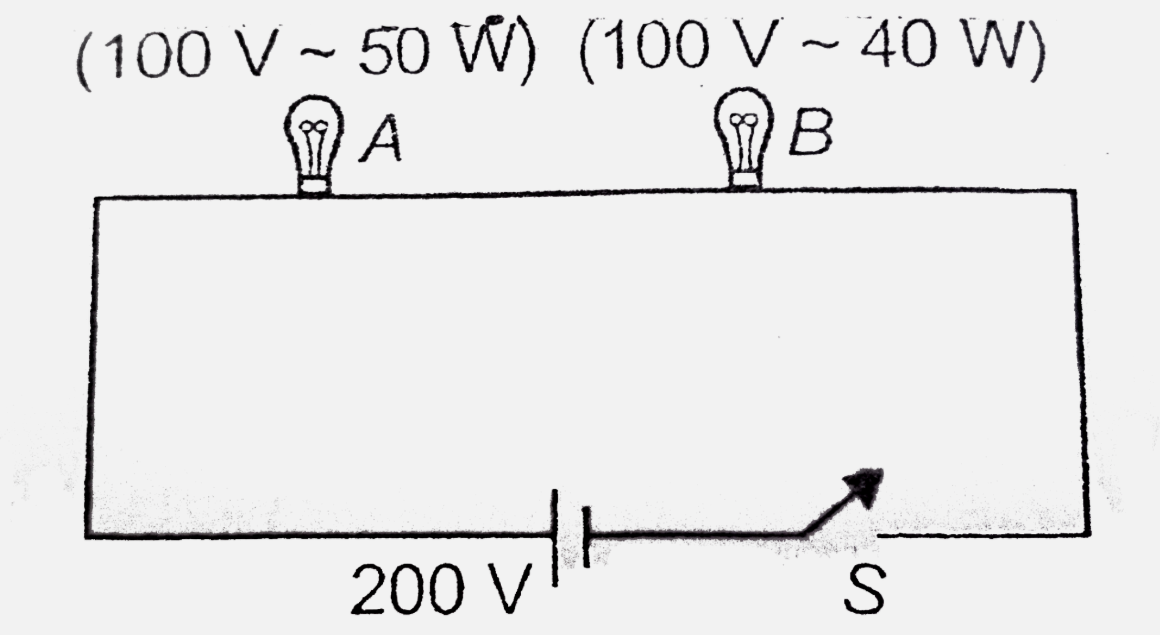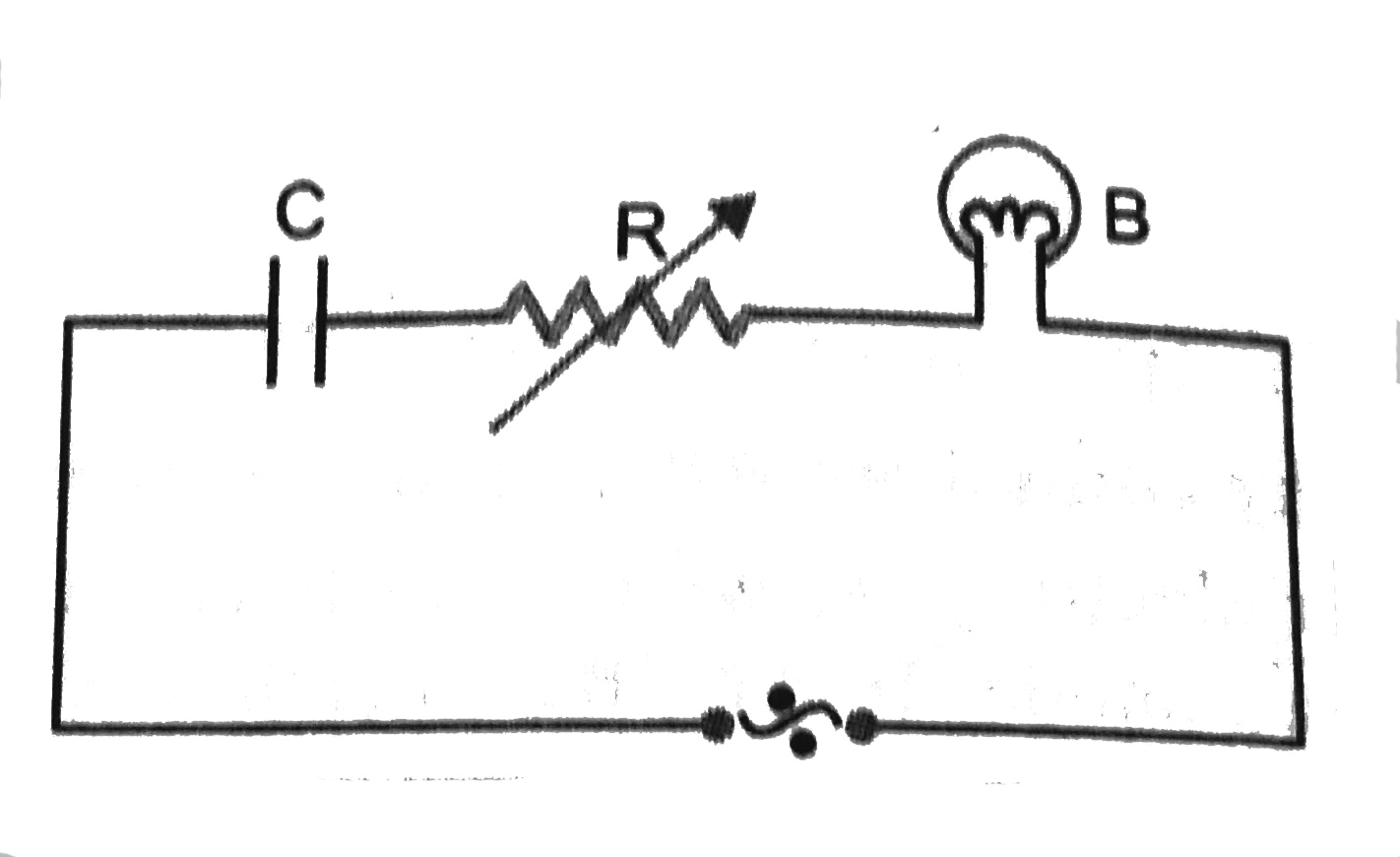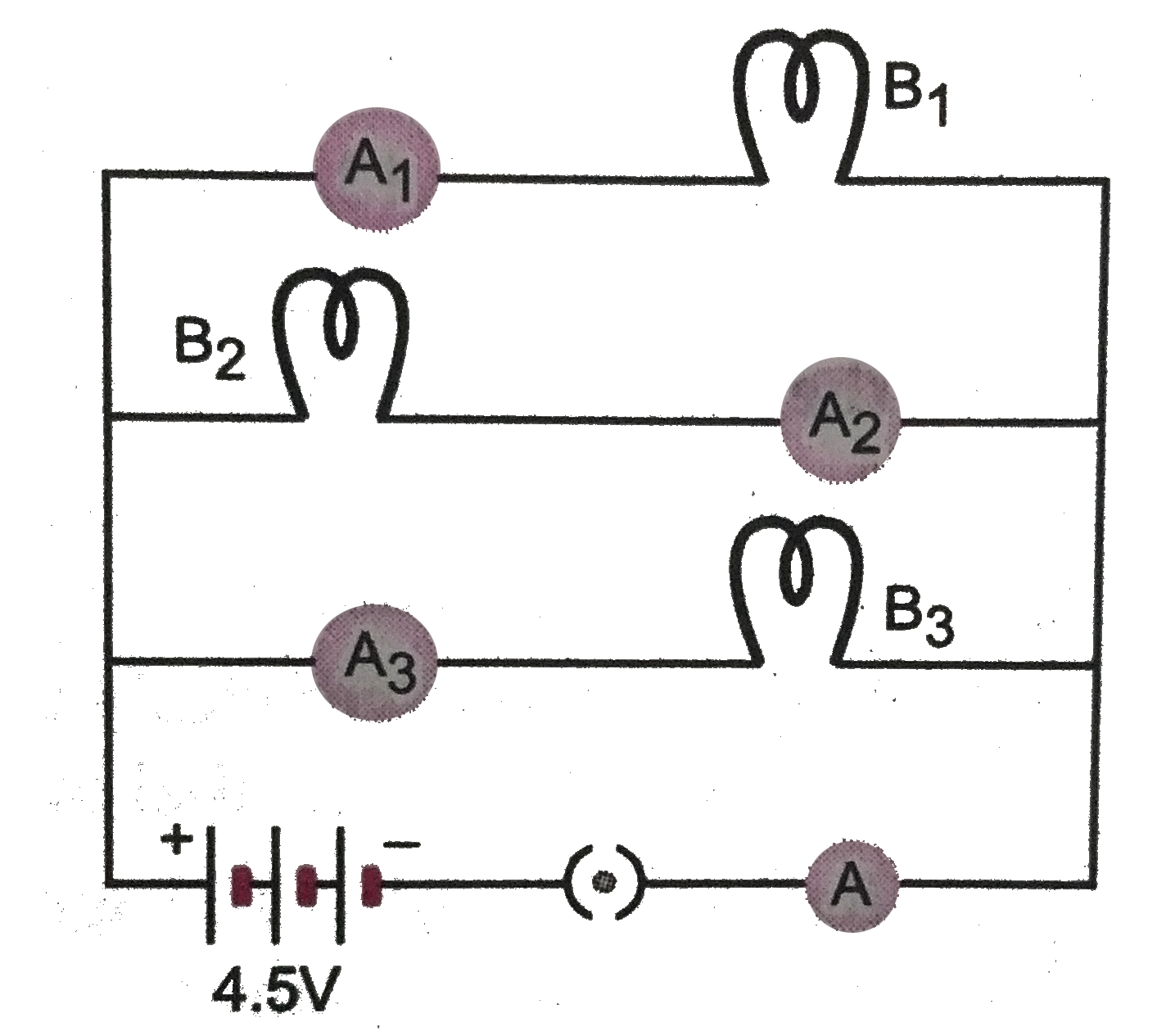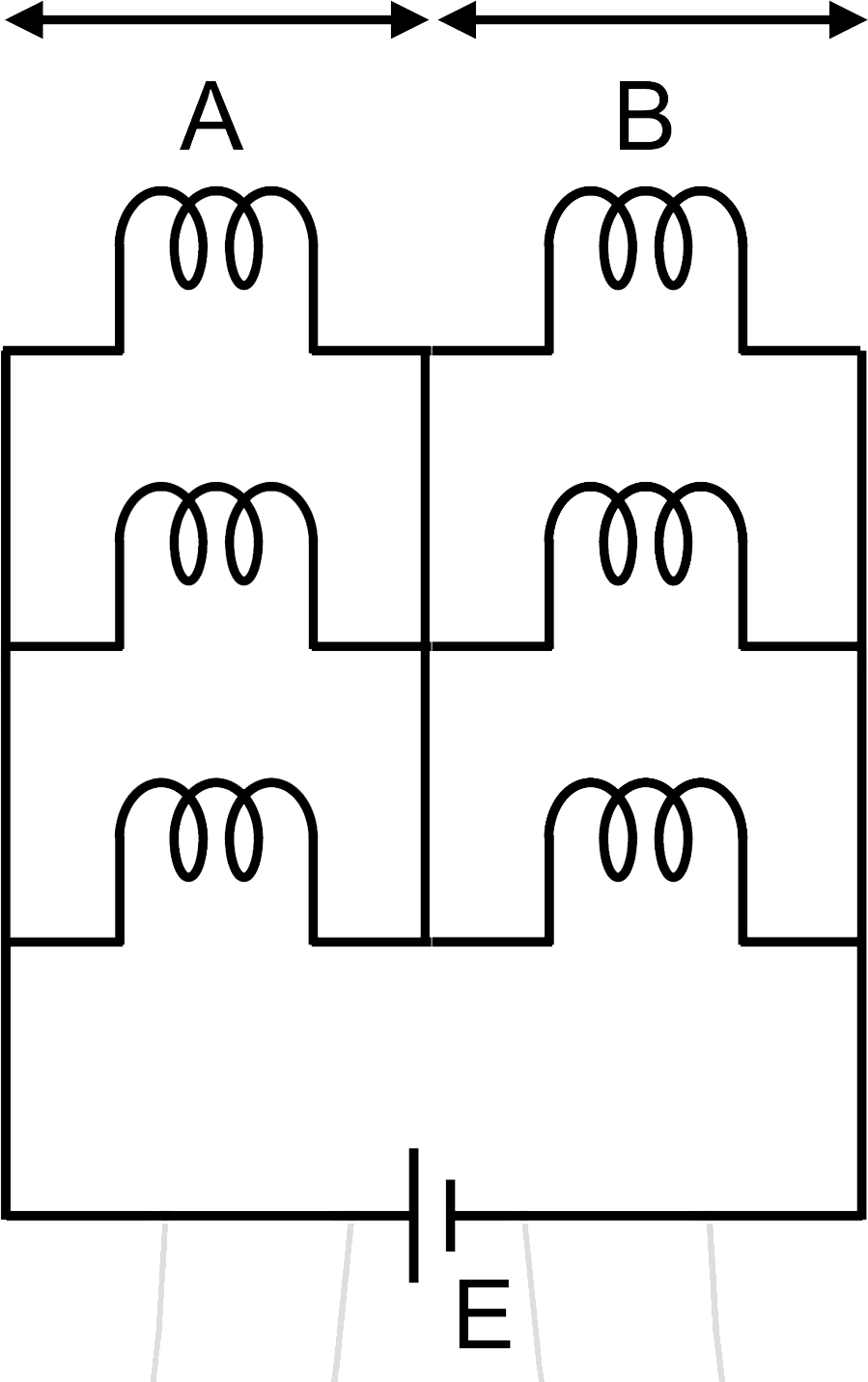Two sets A and B each of four bulbs are glowing in two separate rooms. When one of the bulbs in set A is fused, the other three bulbs also cease to glow. But in set B, when one bulb fuses, the other bulbs continue to glow. (i) Explain the difference in the two sets. (ii) Which set of arrangement is preferred in housing circuit and why ?
Step-by-Step Solution:
1. Understanding Set A:
- In set A, the bulbs are connected in series. This means that the current flows through each bulb one after the other.
- When one bulb in set A fuses (breaks), it creates an open circuit. This interruption stops the flow of current to all the bulbs in the series, causing all of them to go out.
2. Understanding Set B:
- In set B, the bulbs are connected in parallel. In this arrangement, each bulb has its own separate path for the current to flow.
- When one bulb in set B fuses, the other bulbs remain lit because the current can still flow through the other paths. Thus, the fusing of one bulb does not affect the operation of the others.
Conclusion for Part (i):
- The key difference is that in set A (series connection), the failure of one bulb affects all, while in set B (parallel connection), the failure of one bulb does not affect the others.
---
(ii) Which set of arrangement is preferred in housing circuit and why?
1. Preference for Parallel Connection:
- The parallel arrangement (set B) is preferred for household circuits because:
- Each appliance (or bulb) operates independently. If one appliance fails, it does not disrupt the operation of others.
- Each bulb receives the full voltage supply (e.g., 220V), ensuring they operate at their rated brightness.
- It allows for more flexibility in adding or removing appliances without affecting the entire circuit.
2. Advantages of Parallel Connection:
- Increased reliability: If one bulb fails, the others continue to function.
- Consistent brightness: All bulbs receive the same voltage, leading to uniform brightness.
- Easier maintenance: Individual appliances can be serviced without shutting down the entire circuit.
Conclusion for Part (ii):
- The parallel arrangement is preferred in household circuits due to its reliability, consistent voltage supply, and ease of maintenance.
---
- In set A, the bulbs are connected in series. This means that the current flows through each bulb one after the other.
- When one bulb in set A fuses (breaks), it creates an open circuit. This interruption stops the flow of current to all the bulbs in the series, causing all of them to go out.
- In set B, the bulbs are connected in parallel. In this arrangement, each bulb has its own separate path for the current to flow.
- When one bulb in set B fuses, the other bulbs remain lit because the current can still flow through the other paths. Thus, the fusing of one bulb does not affect the operation of the others.
- The key difference is that in set A (series connection), the failure of one bulb affects all, while in set B (parallel connection), the failure of one bulb does not affect the others.
- The parallel arrangement (set B) is preferred for household circuits because:
- Each appliance (or bulb) operates independently. If one appliance fails, it does not disrupt the operation of others.
- Each bulb receives the full voltage supply (e.g., 220V), ensuring they operate at their rated brightness.
- It allows for more flexibility in adding or removing appliances without affecting the entire circuit.
- Increased reliability: If one bulb fails, the others continue to function.
- Consistent brightness: All bulbs receive the same voltage, leading to uniform brightness.
- Easier maintenance: Individual appliances can be serviced without shutting down the entire circuit.
- The parallel arrangement is preferred in household circuits due to its reliability, consistent voltage supply, and ease of maintenance.
Topper's Solved these Questions
- HOUSEHOLD CIRCUITS BOOK - ICSECHAPTER - HOUSEHOLD CIRCUITS EXERCISE - EXERCISE -9(A) (MULTIPLE CHOICE TYPE)
3 Videos
- HOUSEHOLD CIRCUITS BOOK - ICSECHAPTER - HOUSEHOLD CIRCUITS EXERCISE - EXERCISE -9(B)
58 Videos
- HOUSEHOLD CIRCUITS BOOK - ICSECHAPTER - HOUSEHOLD CIRCUITS EXERCISE - EXERCISE -9(B) (MULTIPLE CHOICE TYPE)
2 Videos
- FORCE BOOK - ICSECHAPTER - FORCE EXERCISE - EXERCISE 1( C) Multiple Choice questions
2 Videos
- MACHINESBOOK - ICSECHAPTER - MACHINESEXERCISE - EXERCISE-3(B) NUMERICALS
11 Videos
Similar Questions
Two sets A and B, of three bulbs each, are glowing in two separate rooms. When one of the bulbs in set A is fused, the other two bulbs also cease to glow. But in set B, when one bulb fuses, the other two bulbs continue to glow. Explain why this phenomenon occurs.
View SolutionTwo sets A and B, of three bulbs each, are glowing in two separate rooms. When one of the bulbs in set A is fused, the other two bulbs also cease to glow. But in set B, when one bulb fuses, the other two bulbs continue to glow. Why do we prefer arrangements of Set B for house circuiting?
View SolutionOf the bulbs in a house, one glows brighter than the other, which of the two has a large resistance.
View SolutionTwo bulbs A and B are connected as shown . When switch 'S' is closed then which of them will fuse?

View SolutionA capacitor C, a variable resistor R and a bulb B are connected in series to the ac mains in circuits as shown if Fig. The bulb glows with some brightness. How will the glow of the bulb change if (i) a dielectric slab is introduced between the plates of the capacitor, keeping resistance T to be the same, (ii) the resistance R to be the same, (ii) the resistance R is increased keeping the same capacitance.

View SolutionB1,B2andB3 are three identical bulbs connected as shown in (fig. 3.46). When all the three bulbs glow, a current of 3A is recorded by the ammeter A.
(i) What happens to the glow of the other two bulbs when the bulb B1 gets fused ?
(ii) What happens to the readings of A1,A2,A3andA when the bulb B2 gets fused ?
(iii) How much power is dissipated in the circuit when all the three bulbs glow together ?
 .
.
View SolutionThree incandecent bulbs of 100W each are connected in series in an electric circuit. In another circuit another set of three bulbs of the same wattage are connected in parallel to the same source.
(a) Will the bulbs in the two circuits glow with the same brightness ? Justify your answer.
(b) Now let one bulb in both the circuits get fused. Will the rest of the bulbs continue to glow in each circuit ? Give reason.
View SolutionSix similar bulbs are connected as shown in the figure with a DC source of emf E, and zero intermal resistance.
The ratio of power consumption by the bulbs when (i) all are glowing and (ii) in the situation when two from section A and one from section B are glowing, will be:

View SolutionIf two bulbs of 25Wand100W rated at 220V are connected in series across a 440V supply, will both the bulbs fuse ? If not which one ?
View SolutionThere are two electric bulbs of 40W and 100W. Which one will be brighter when first connected in series and then in parallel ?
View Solution
